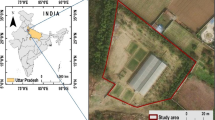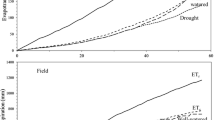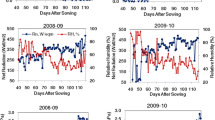Abstract
A subsurface drip irrigation study with cotton used canopy temperature to determine signals for irrigation control during 2002–2004. Timing of irrigation applications was controlled by the biologically identified optimal temperature interactive console (BIOTIC) protocol, which used stress time (ST) and a crop-specific optimum temperature to indicate water stress. ST was the cumulative daily time quantity when cotton canopy temperature exceeded 28°C. STs between 5.5 and 8.5 h in 1 h increments were irrigation signal criteria, which produced different irrigation regimes. This investigation examined the association among ST, daily average canopy temperature (T c), canopy and air temperature difference (T c−T a), and the relative crop water stress index (RCWSI) including their relationship with lint yield. Number of irrigation signals decreased linearly with ST at the rate of −10.2 and −8.7 irrigations per 1 h increase of ST in 2003 and 2004. There were significant curvilinear relationships between ST and the average daily stress on days with irrigation signals and for days without irrigation signals across years. The percentage of positive daily (T c−T a) values increased with ST level. ST and T c were positively related in all irrigation signal treatments with 5.5 and 6.5 h being significant in 2003 and 2004. Yield declined at the rate of 343 kg lint/ha for each 1 h increase of ST for days with irrigation signals. ST, mathematically the most simple of the canopy temperature-based parameters, provided the most consistent estimate of crop water stress and correlation with lint yield. The power of ST to characterize water stress effects on crop productivity evolves from being an integrated value of time while canopy temperature exceeds a physiologically based threshold value.










Similar content being viewed by others
Notes
Mention of trade names or commercial products in this publication is for the purpose of providing specific information and does not imply recommendation or endorsement by the U.S. Department of Agriculture.
References
Ehrler WL, Idso SB, Jackson RD, Reginato RJ (1978) Wheat canopy temperature: relation to plant water potential. Agron J 70:251–256
Gardner BR, Nielsen DC, Shock CC (1992) Infrared thermometry and the crop water stress index. II. Sampling procedure and interpretation. J Prod Agric 5:466–475
Idso SB (1982) Non-water-stressed baselines: a key to measuring and interpreting plant water stress. Agric Meteor 27:59–70
Idso SB, Jackson RD, Pinter PJ Jr, Reginato RJ, Hatfield JL (1981) Normalizing the stress-degree day parameter for environmental variability. Agric Meteor 24:45–55
Irmak S, Haman DZ, Bastug R (2000) Determination of crop water stress index for irrigation timing and yield estimation of corn. Agron J 92:1221–1227
Jackson RD, Idso SB, Reginato RJ, Pinter PJ Jr (1981) Canopy temperature as a crop water stress indicator. Water Resour Res 17:1133–1138
Jackson RD, Kustas WP, Choudhury BJ (1988) A reexamination of the crop water stress index. Irrig Sci 9:309–317
Kacira M, Ling PP, Short TH (2002) Establishing crop water stress index (CWSI) threshold values for early, non-contact detection of plant water stress. Trans ASAE 45:775–780
Tanner CB (1963) Plant temperatures. Agron J 55:210–211
Wanjura DF, Mahan JR (1994) Thermal environment of cotton irrigated using canopy temperature. Irrig Sci 14:199–205
Wanjura DF, Upchurch DR (2002) Water status response of corn and cotton to altered irrigation. Irrig Sci 21:45–55
Upchurch DR, Wanjura DF, Burke JJ, Mahan JR (1996) Biologically-identified optimal temperature interactive console (BIOTIC) for managing irrigation. U.S. Patent 5,539,637 (23 July 1996)
Author information
Authors and Affiliations
Corresponding author
Additional information
Communicated by P. Waller
Rights and permissions
About this article
Cite this article
Wanjura, D.F., Upchurch, D.R. & Mahan, J.R. Behavior of temperature-based water stress indicators in BIOTIC-controlled irrigation. Irrig Sci 24, 223–232 (2006). https://doi.org/10.1007/s00271-005-0021-9
Received:
Accepted:
Published:
Issue Date:
DOI: https://doi.org/10.1007/s00271-005-0021-9




